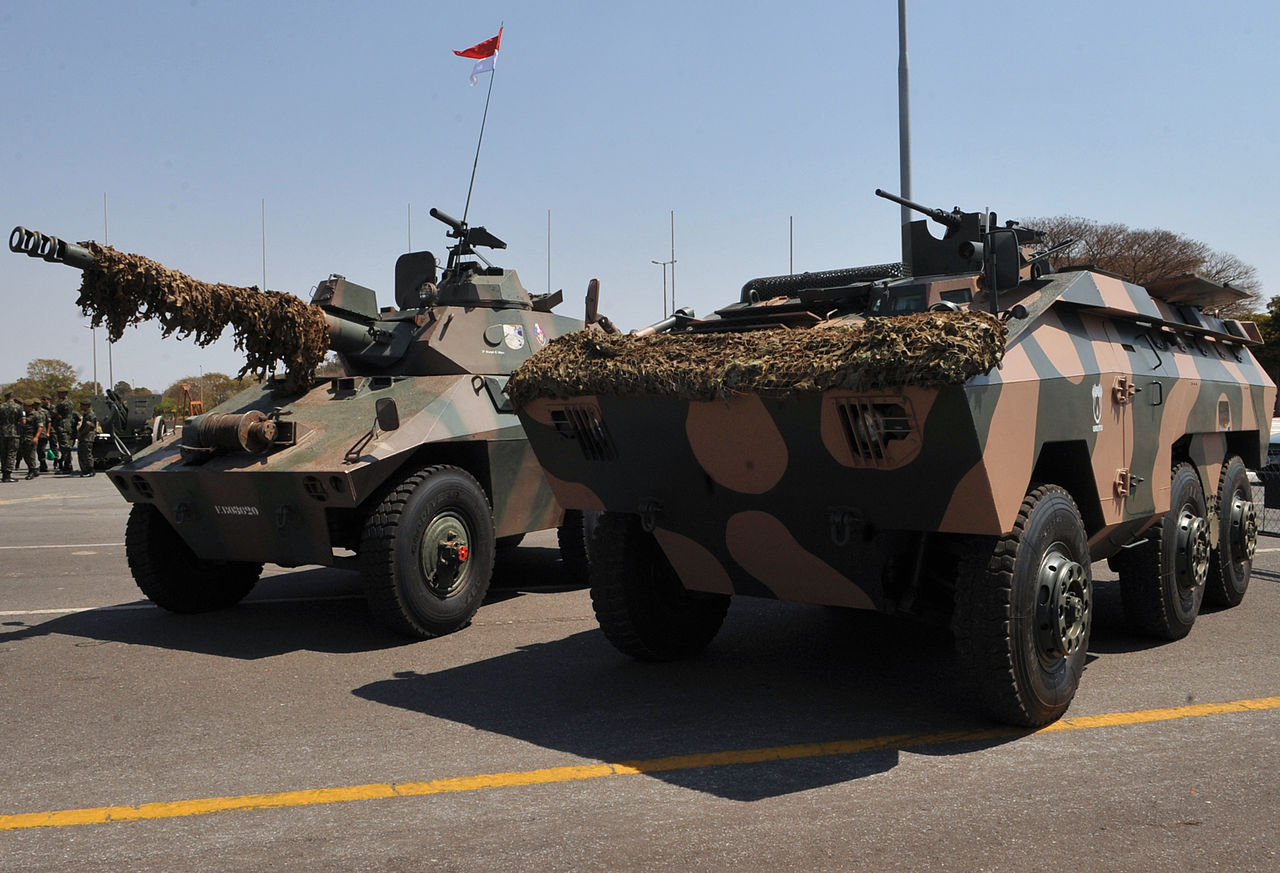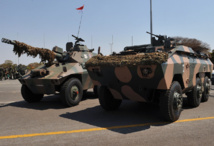The end of the Cold War and the reduction of defense budgets suggested the decline of orders worldwide. In fact, nothing of the sort is seen.
Cycles of modernization in this area last for a very long time, and today we can see (unfortunately for the future of our planet) accelerating renovation of military equipment. Military spending worldwide ($ 1.8 trillion over the past year) are kept at a high level, and the increase in costs in the Middle East, Eastern Europe, Asia and Africa offset the reduction of the US military budget.
Thus, according to the Stockholm Peace Research Institute, the world's arms exports increased by 16% between 2010 and 2014 in relation to the 2005-2009 years: the US (they still retain a leading position on the market) got an increase of 23% and Russia - 31%. In addition, a rapid growth of Chinese exports should be noted, which amounted to over 143% this time, holding up Beijing for the third place in the ranking of the largest suppliers.
The Gulf States and Asia in turn are the largest customer. So, for the period under review, the members of the Cooperation Council of Arab Gulf States (Saudi Arabia, Oman, Kuwait, Bahrain, the UAE and Qatar) increased their purchases of weapons by 71%. France plays a special role in the region, as demonstrated by the presence of Francois Hollande at the meeting of the Cooperation Council on May 4 - he became the first foreign head of state invited to such a meeting.
It is therefore hardly a coincidence that Qatar showed up among the three countries, which ordered Rafale from Paris (24 aircraft).
India, too, has been conducting protracted negotiations to buy Rafale not for the first year. Over the past five years, the volume of its weapons imports increased by 15%, and the government eventually reached an agreement with Paris for the supply of 36 aircraft.
Egypt also receive 24 Rafale (and a frigate for the Navy) under the guarantee of the French state on half of the contract.
In total, the French defense industry has received an order for 84 machines. Contracts for the supply of Rafale were signed after the country's arms exports grew in 2014 by 17% to reach 8 billion euros. Thus, in spite of the disastrous 2012, the French defense industry earned from 2011 to 2014 orders more than $ 25 billion. The results of 2015 look even more impressive.
In addition, recent agreements say that the credibility of France in the international market has not suffered, despite disagreements with Russia over the Mistrals.
All these states are not new markets for Dassault Aviation. Egypt already has Mirage 5 and Mirage 2000, Qatar - Mirage F1 and Mirage 2000, and Mirage 2000 stays in India.
However, all of these clients have other machines at their service, starting with the Russian MiG and American F-16 and F-18 of the Indian Army. They could choose aircraft rivals like Swedish Gripen (like Brazil), or Russian and American companies. However, while Gripen managed to get ahead of the Rafale for a competitive price (it is cheaper by about 30%), the French aircraft has a significant advantage in combat characteristics.
As for the European rival Eurofighter (developed by the United Kingdom, Germany and Italy), it cannot offer such a flexible application, thus limiting the possibilities for operations.
French aircraft, in turn, was originally designed to perform a wide array of tasks (air strikes, aerial combat, intelligence).
The government had a lot of doubts, including the Jacques Chirac’s. Then Defense Minister André Giraud was worried that France alone embarking on such a massive industrial venture, taking into account the fact that developed in the same time the Eurofighter could count on for larger by default backlog of orders in connection with the co-operation of several states in the project. It would affect the value of the aircraft, the state of the French defense budget and competitiveness in the global market.
Nevertheless, thanks to strong lobbying and support of François Mitterrand, Dassault still got the go-ahead and even drew away its partners Thomson and Snecma. Interests of the defense industry and strategies of sovereignty then meant more than budget imperatives.
The program brought a storm of criticism upon themselves, but today a multi-purpose nature of aircraft becomes an advantage to one-thing specialized competitors. Rafale’s multitasking allows to optimize resources, what becomes even more important, since the aircraft is purchased for 30 years, and it’s not possible to anticipate the need for such a long run.
Altogether, the production of Rafale involves about 500 subcontractors at various levels. With all of this, the aircraft orders has the most positive effect on the employment situation: as noted by Jean-Yves Le Drian, it is about 30 000 new jobs in the defense industry for a period of several years.
In addition, since the start of Rafale’s program, the aircraft has changed a lot, absorbing the technological innovations. Signing of contracts also witnesses the recognition of French experience in the high-tech industry abroad. Military aircraft - this is one of those sectors that do not tolerate any compromises in the application of innovation, computerization tasks and forming the human-machine interface.
source: slate.fr
Cycles of modernization in this area last for a very long time, and today we can see (unfortunately for the future of our planet) accelerating renovation of military equipment. Military spending worldwide ($ 1.8 trillion over the past year) are kept at a high level, and the increase in costs in the Middle East, Eastern Europe, Asia and Africa offset the reduction of the US military budget.
Thus, according to the Stockholm Peace Research Institute, the world's arms exports increased by 16% between 2010 and 2014 in relation to the 2005-2009 years: the US (they still retain a leading position on the market) got an increase of 23% and Russia - 31%. In addition, a rapid growth of Chinese exports should be noted, which amounted to over 143% this time, holding up Beijing for the third place in the ranking of the largest suppliers.
The Gulf States and Asia in turn are the largest customer. So, for the period under review, the members of the Cooperation Council of Arab Gulf States (Saudi Arabia, Oman, Kuwait, Bahrain, the UAE and Qatar) increased their purchases of weapons by 71%. France plays a special role in the region, as demonstrated by the presence of Francois Hollande at the meeting of the Cooperation Council on May 4 - he became the first foreign head of state invited to such a meeting.
It is therefore hardly a coincidence that Qatar showed up among the three countries, which ordered Rafale from Paris (24 aircraft).
India, too, has been conducting protracted negotiations to buy Rafale not for the first year. Over the past five years, the volume of its weapons imports increased by 15%, and the government eventually reached an agreement with Paris for the supply of 36 aircraft.
Egypt also receive 24 Rafale (and a frigate for the Navy) under the guarantee of the French state on half of the contract.
In total, the French defense industry has received an order for 84 machines. Contracts for the supply of Rafale were signed after the country's arms exports grew in 2014 by 17% to reach 8 billion euros. Thus, in spite of the disastrous 2012, the French defense industry earned from 2011 to 2014 orders more than $ 25 billion. The results of 2015 look even more impressive.
In addition, recent agreements say that the credibility of France in the international market has not suffered, despite disagreements with Russia over the Mistrals.
All these states are not new markets for Dassault Aviation. Egypt already has Mirage 5 and Mirage 2000, Qatar - Mirage F1 and Mirage 2000, and Mirage 2000 stays in India.
However, all of these clients have other machines at their service, starting with the Russian MiG and American F-16 and F-18 of the Indian Army. They could choose aircraft rivals like Swedish Gripen (like Brazil), or Russian and American companies. However, while Gripen managed to get ahead of the Rafale for a competitive price (it is cheaper by about 30%), the French aircraft has a significant advantage in combat characteristics.
As for the European rival Eurofighter (developed by the United Kingdom, Germany and Italy), it cannot offer such a flexible application, thus limiting the possibilities for operations.
French aircraft, in turn, was originally designed to perform a wide array of tasks (air strikes, aerial combat, intelligence).
The government had a lot of doubts, including the Jacques Chirac’s. Then Defense Minister André Giraud was worried that France alone embarking on such a massive industrial venture, taking into account the fact that developed in the same time the Eurofighter could count on for larger by default backlog of orders in connection with the co-operation of several states in the project. It would affect the value of the aircraft, the state of the French defense budget and competitiveness in the global market.
Nevertheless, thanks to strong lobbying and support of François Mitterrand, Dassault still got the go-ahead and even drew away its partners Thomson and Snecma. Interests of the defense industry and strategies of sovereignty then meant more than budget imperatives.
The program brought a storm of criticism upon themselves, but today a multi-purpose nature of aircraft becomes an advantage to one-thing specialized competitors. Rafale’s multitasking allows to optimize resources, what becomes even more important, since the aircraft is purchased for 30 years, and it’s not possible to anticipate the need for such a long run.
Altogether, the production of Rafale involves about 500 subcontractors at various levels. With all of this, the aircraft orders has the most positive effect on the employment situation: as noted by Jean-Yves Le Drian, it is about 30 000 new jobs in the defense industry for a period of several years.
In addition, since the start of Rafale’s program, the aircraft has changed a lot, absorbing the technological innovations. Signing of contracts also witnesses the recognition of French experience in the high-tech industry abroad. Military aircraft - this is one of those sectors that do not tolerate any compromises in the application of innovation, computerization tasks and forming the human-machine interface.
source: slate.fr



















